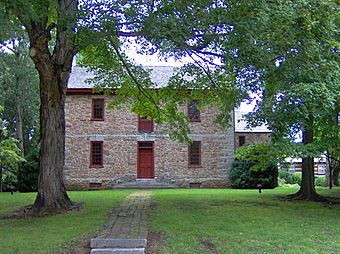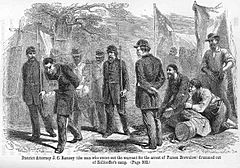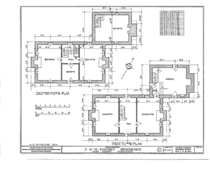Ramsey House (Knox County, Tennessee) facts for kids
Quick facts for kids |
|
|
Ramsey House
|
|

The Ramsey House
|
|
| Location | SE of Knoxville on Thorngrove Pike |
|---|---|
| Nearest city | Knoxville, Tennessee |
| Built | 1797 |
| Architect | Thomas Hope |
| NRHP reference No. | 69000180 |
| Added to NRHP | December 23, 1969 |
The Ramsey House is a historic two-story stone house located in Knox County, Tennessee, United States. It's also known as Swan Pond. An English architect named Thomas Hope built the house in 1797 for Colonel Francis Alexander Ramsey.
The Ramsey family lived here and ran a large farm until the U.S. Civil War. In 1969, the house was added to the National Register of Historic Places. This recognized its special architecture and its important role in the area's history during the early 1800s.
Francis Alexander Ramsey first explored this area in 1783. He later served in the governments of the early State of Franklin and the Southwest Territory. His children included W. B. A. Ramsey, an early mayor of Knoxville, and J. G. M. Ramsey, a historian. Both lived in the Ramsey House at different times.
During the Civil War, the Ramseys supported the Confederate States of America. They left Knoxville when the Union Army took control of the city. The family sold the house in 1866.
Today, the Knoxville Chapter of the Association for the Preservation of Tennessee Antiquities (APTA) owns the Ramsey House. They bought it in 1952 and keep it as a museum for everyone to visit.
Contents
Where is the Ramsey House Located?
The Ramsey House sits in a wide valley. It's just over a mile east of a place called Forks-of-the-River. This is where the Holston River and French Broad River meet to form the Tennessee River.
The property managed by APTA includes the house, a visitor's center, and gardens. It covers about 101.5 acres (41.1 ha). You can find the house and its grounds at 2614 Thorngrove Pike, near John Sevier Highway (TN-168).
The Story of Ramsey House
How the Ramsey House Began
Francis Alexander Ramsey was born in Pennsylvania in 1764. His family came from Scotland and Ireland. He moved to Greene County, Tennessee, in 1783. That year, North Carolina opened up new lands for settlement. Ramsey and other explorers began looking for new places to live near what is now Knoxville.
On one trip, Ramsey found a pond full of beavers and game. He named it "Swan Pond." He received official ownership of Swan Pond and the land around it in 1786.
Ramsey became important in the short-lived State of Franklin government. In 1792, he decided to move to Swan Pond. This was just outside Knoxville, which was the capital of the new Southwest Territory. Ramsey chose to build his house on a small piece of land in the pond. However, he had to drain the pond first because of concerns about diseases like malaria.
London-trained architect Thomas Hope designed the house. He likely built it between 1795 and 1797.
Over the years, the Ramsey House became part of a large farm. When Francis Ramsey passed away in 1820, his oldest son, W.B.A. Ramsey, inherited the house. In 1840, W.B.A. Ramsey sold the house to his brother, J.G.M. Ramsey.
J.G.M. Ramsey was very interested in the region's history. He built another large home nearby called "Mecklenburg." This home had a huge library with 4,000 books and old documents about Tennessee's settlement. In 1857, J.G.M. Ramsey gave the Ramsey House to his son, also named Francis Alexander Ramsey, as a wedding gift.
The Civil War Years
J.G.M. Ramsey was very active in helping East Tennessee grow. He helped start the area's first medical group and worked to bring railroads to the region. In the late 1850s, Ramsey had disagreements with William G. "Parson" Brownlow. Brownlow was a powerful newspaper publisher in Knoxville.
Brownlow often criticized the leaders of the Bank of East Tennessee, including Ramsey. He also made accusations against Ramsey's son, John Crozier Ramsey. These arguments were part of the growing tensions before the Civil War.
When the Civil War began, the Ramsey family supported the Southern states (the Confederacy). This put them even more at odds with Brownlow, who strongly opposed leaving the Union. In 1861, John Crozier Ramsey, who was a district attorney, had Brownlow arrested. Brownlow was accused of working against the Confederacy.
The Ramseys wanted Brownlow to be punished severely. However, the Confederate Army released him to avoid public anger. Because of Brownlow's influence, J.G.M. Ramsey's Mecklenburg mansion was burned down. This happened when the Union Army took over Knoxville in 1863.
With their home destroyed, the Ramseys, who had left Knoxville in 1863, decided not to return. The Ramsey House was sold to William Spurgien in 1866. After this, the house began to fall into disrepair. J.G.M. Ramsey eventually moved back to Knoxville in the 1870s. He was very sad to see the Ramsey House in such poor condition. He even wrote a poem about its decline in his autobiography.
Saving the Ramsey House
In 1927, a group called the Bonnie Kate Chapter of the Daughters of the American Revolution placed a marker at the Ramsey House. It honored the site as the birthplace of J.G.M. Ramsey. His book, Annals of Tennessee, had become a very important record of the state's early history.
In the 1930s, the house was studied by the Historic American Buildings Survey. Then, in 1952, the APTA's Knoxville Chapter bought the house. They received help from state and local governments. The group began working to restore the house to its original look.
They replaced the roof and windows. An old log cabin was also moved to the property. This cabin represents the temporary home the Ramseys used in the 1790s while their main house was being built.
What Does the Ramsey House Look Like?
The Ramsey House is a two-story house built in the Late Georgian style. It's mostly made of beautiful local pink marble. It also has bluish-gray limestone for decoration. This limestone forms a "belt" around the middle of the house and at its four corners.
The house has a special "dogtrot" kitchen wing. This means the kitchen part is connected to the main house in a unique way. Outside, you can see fancy hand-carved decorations called cornices. The window arches are made of nine narrow stones each.
Inside, the house has a central hallway. The front door opens into this hall. To the left is a library/parlor room, and to the right is a dining room. Upstairs, there are two bedrooms and an extra room. There used to be a door leading to the porch roof, but the porch is no longer there.
The kitchen wing also has two stories. However, you can't walk directly from the second floor of the main house to the second floor of the kitchen wing. The house has three chimneys and six fireplaces in total. The inside of the house is decorated with furniture from that time period. Two special Chippendale chairs were given to Francis Alexander Ramsey and his wife, Peggy, as a wedding gift.
See also
- Alexander Bishop House
- Blount Mansion
- Craighead-Jackson House
- James Park House
- Statesview
- History of Knoxville, Tennessee
Resources
- Isenhour, Judith Clayton. Knoxville - A Pictorial History. (Donning, 1978), page 20.
- Rothrock, Mary U., editor. The French Broad-Holston Country: A History of Knox County, Tennessee. (Knox County Historical Committee; East Tennessee Historical Society, 1946).
- Knoxville: Fifty Landmarks. (Knoxville: The Knoxville Heritage Committee of the Junior League of Knoxville, 1976), p. 9.




